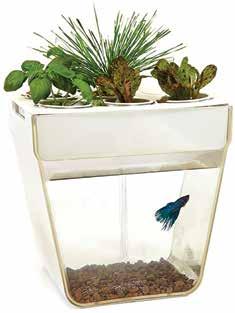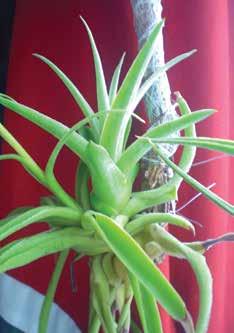
2 minute read
Growing indoor plants in the winter: Air plants and aquaponics

By Molly Milroy
Spring is just around the corner, we can almost feel it. Almost. If you’re anxious to get started on your gardening and landscaping, but the frozen ground is keeping you from playing in the dirt outside, try your hand at indoor plants. Here are two fresh ideas to grow indoor plants during the wintertime.
Air Plants
Tillandsia, otherwise known as air plants, are an excellent way to give your home a bit of greenery in the wintertime. These plants thrive on the nutrients in the air, hence their name. One of the unique traits to these plants is that they don’t require any soil and they are very low maintenance. Although, in order to thrive, they do need the right amount of water and light, along with the right temperature.
For an air plant beginner, University of Minnesota-Duluth Greenhouse Manager Matthew Jahnke explains: “Since air plants don't have roots like a typical plant does, they require daily misting. They could go a couple days without water but daily misting with a spray bottle would be best.”
Some common plants to begin with are Tillandsia Ionantha air plants and Tillandsia stricta air plants.

“Spanish moss, ironically not Spanish and not a moss, is a long, drooping, graceful one that is fairly common,” said Jahnke.
Air plants are a great addition to a home and are easy to display.
“Air plants can be mounted, displayed, or suspended in a variety of ways,” Jahnke said. “They look cool and unusual and you can get quite artistic in the way you present them.”
Many people will decorate their homes with air plants, hanging them from the ceiling, putting them on a desk or shelf near a window. You can find a variety of plants to purchase from Etsy vendors or a local flower shop.
Aquaponics
“Aquaponics combines aquaculture (growing aquatic animals like fish in a controlled setting) with hydroponics (growing plants in water instead of soil),” explained Jahnke. “The excrement of the animals is broken down into nutrients that can serve as fertilizer for the plants. This natural removal of excrement benefits the animals by providing a cleaner, less toxic aquatic environment.”
A common way to grow plants is to have them grow on top of the water with fish living below. The roots of the plants that dangle below the water then absorbs the nutrients.
Typical plants grown include leafy greens such as kale, spinach and basil. Lettuce is one of the most common greens to grow because of their quick turnaround, in just 28 days. If you want to start small, check out the aquaponic tanks at PetSmart or Home Depot. These are the perfect way to start your aquaponic hobby. Or, if you’re interested in hydroponics, visit Duluth Hydroponics on First Street in downtown Duluth.
Indoor plants bring a lot of benefits to a home including acting as air purifiers, helping boost mood, and even improving attention. If you are looking at a way to add some green to your home before the snow melts, then try these two fun and unique ways of growing indoor plants in the wintertime. The entire household will benefit from it! D
Molly Milroy is a Duluth freelance writer.












